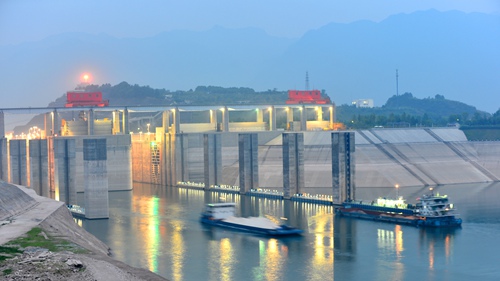|
 |
|
AWAITING THE FLOOD: A ship passes through a gate in the Three Gorges Reservoir in Yichang, Hubei Province, on June 9. The reservoir is fully prepared for the coming flood season (ZHENG JIAYU) |
IPO Resumes
The China Securities Regulatory Commission (CSRC) approved 10 initial public offering (IPO) applications on June 9, marking the first official restart of IPOs since mid-February.
Five applicants will be listed on the Shanghai Stock Exchange and the rest on the Shenzhen Stock Exchange, the CSRC said in a Weibo posting. But it did not reveal their names.
The applicants and their brokers will set the share-issuing dates after talking with the two bourses and release their prospectuses in the coming days.
The commission plans to approve some 100 IPO applicants from June to the year-end. About 600 companies are now awaiting listing on the mainland's two stock exchanges.
Logistics Plan
The State Council, China's cabinet, on June 11 approved a plan for the development of the logistics industry.
The plan specifies 12 key projects in the sector, including farm produce logistics, manufacturing logistics and supply chain management, as well as logistics for the recycling of renewable resources, said a statement released after a cabinet executive meeting.
The country should have a modern logistics service system in place by 2020 to make the sector more standardized, information-based and intelligent, as well as raise its overall efficiency and profitability, the statement said.
The meeting also decided to implement a single tax rate of 3 percent for companies engaging in running water supply, small-scale hydropower generation and some other areas from July 1. Their tax rates currently range from 3 percent to 6 percent. The cut will reduce the burden of those companies by 24 billion yuan ($3.9 billion) each year, the statement said.
Targeted Easing
China's central bank announced on June 9 that it will cut the reserve requirement ratio (RRR) by 0.5 percentage points for banks engaged in proportionate lending to agricultural and small firms. The cut will take effect from June 16.
The central bank provided the details following a cabinet decision late last month to launch targeted RRR cuts for banks engaged in lending to agriculture-related businesses and small and micro-sized companies, in efforts to enhance financial support for the real economy.
"According to the standard, the targeted RRR cut will cover around two thirds of city commercial banks, 80 percent of rural commercial banks above county level as well as 90 percent of rural cooperative banks above county level," said the central bank.
Meanwhile, the central bank will cut the RRR for finance companies, financial leasing firms, and automobile finance enterprises by 0.5 percentage points. The cut aims to improve the capital use efficiency of these companies and boost consumption, the central bank said.
The new RRR cut is expected to guide credit support to the agricultural sector and small companies, areas that are often deemed to have limited access to financing.
This is the second time within two months that the central bank unveiled a targeted RRR cut to support sections of the economy. On April 22, a RRR reduction was introduced for county-level rural commercial banks and rural credit cooperative unions.
The central bank said this did not mean a change to the country's fundamental monetary policy, however.
Expanding Capacity
China will build a multi-tier transport system along the Yangtze River to help boost construction of an economic belt along the waterway, the State Council said on June 11.
Better use of the so-called "golden waterway" can boost economic integration between developed and impoverished regions and inject fresh energy into China's economic growth, read a statement released after a State Council executive meeting chaired by Premier Li Keqiang.
The country will dredge the Yangtze River and increase the navigation capacity of the Three Gorges Dam, according to the statement.
The State Council said the country is also working on standardized ships adapted for the Yangtze and will encourage the development of energy-saving vessels.
The river runs east to west over 6,300 km and is the world's third largest in terms of length and water volume. The waterway joins less developed inland provinces to prosperous Shanghai. | 